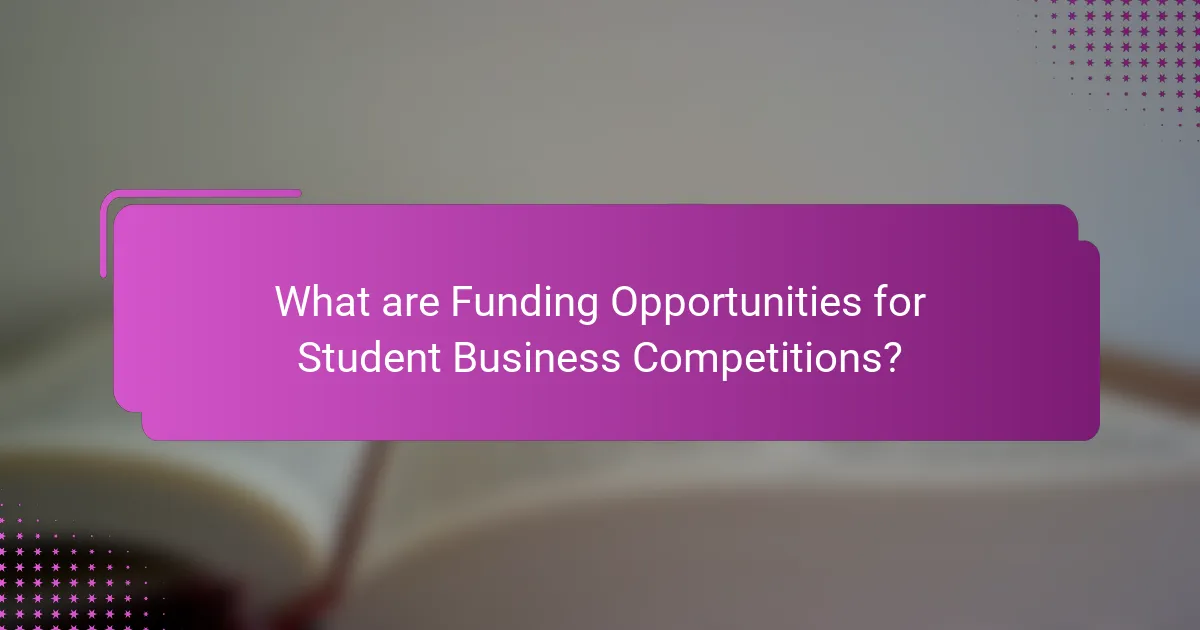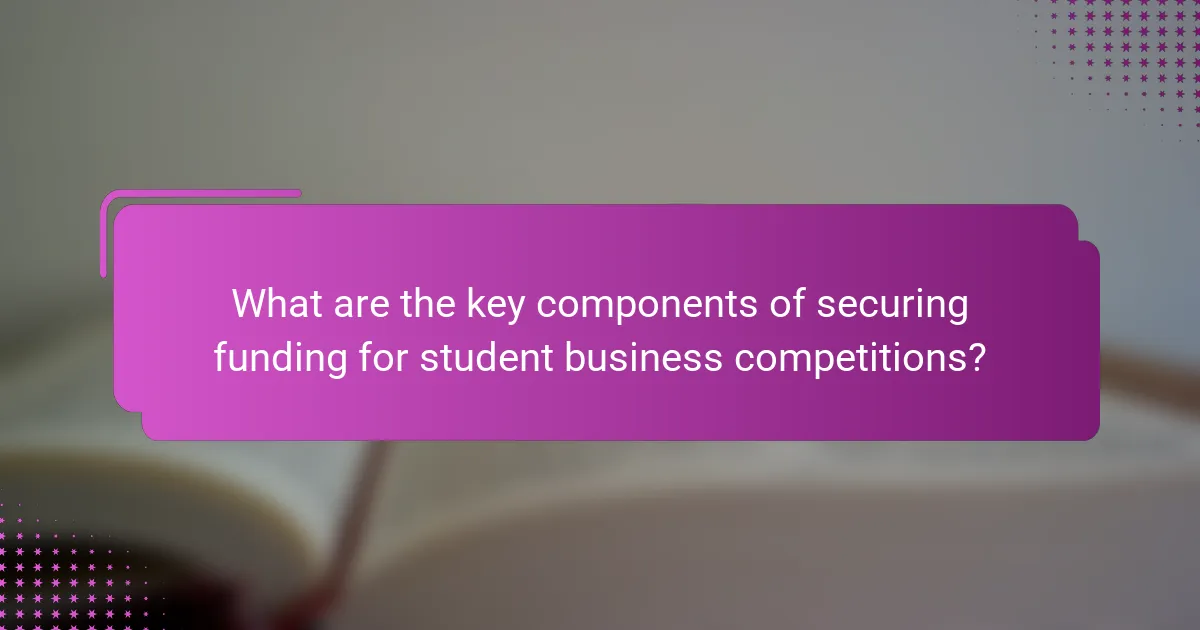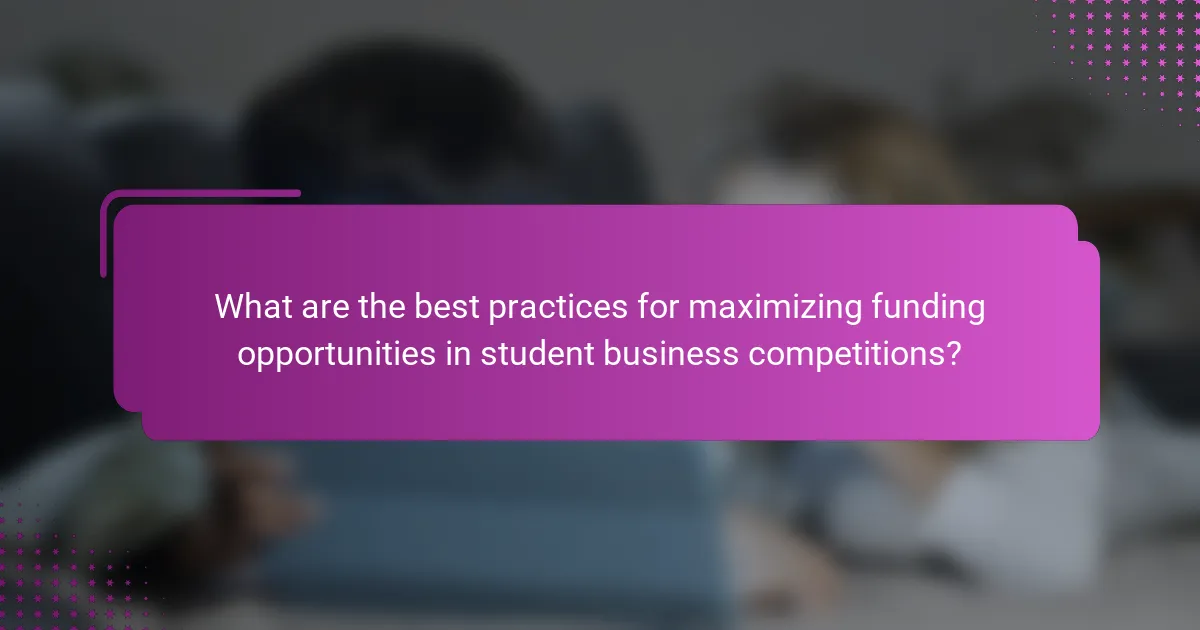Funding opportunities for student business competitions encompass sponsorships, grants, and scholarships, which are essential for supporting young entrepreneurs. Sponsorships typically originate from local businesses or corporations, while grants are often provided by educational institutions or government entities to foster innovation. Scholarships reward students who excel in these competitions, with organizations like the Small Business Administration and the National Association for the Self-Employed offering specific funding to encourage student-led initiatives. Key strategies for securing funding include identifying potential sponsors, crafting compelling proposals, and demonstrating value to funders, as well as actively researching and applying for multiple funding sources. Networking and developing strong business plans are also crucial for maximizing funding opportunities in these competitions.

What are Funding Opportunities for Student Business Competitions?
Funding opportunities for student business competitions include sponsorships, grants, and scholarships. Sponsorships often come from local businesses or corporations looking to support entrepreneurship. Grants may be provided by educational institutions or government entities to promote innovation. Scholarships can be awarded to students who excel in these competitions. For example, the Small Business Administration offers grants for student-led initiatives. Additionally, organizations like the National Association for the Self-Employed provide funding to encourage student entrepreneurship. These funding sources help students cover competition costs and develop their business ideas.
How do Sponsorships, Grants, and Scholarships differ in student business competitions?
Sponsorships, grants, and scholarships differ primarily in their purpose and funding structure. Sponsorships involve businesses providing financial support in exchange for advertising and brand exposure during competitions. Grants are funds awarded based on specific criteria, often aimed at supporting innovative projects or initiatives without the expectation of direct returns. Scholarships are financial awards given to students based on merit or need to help cover educational expenses. Each funding type plays a unique role in supporting student business competitions, with sponsorships focusing on brand visibility, grants targeting project innovation, and scholarships aiding individual student development.
What roles do sponsorships play in supporting student business competitions?
Sponsorships play a crucial role in supporting student business competitions by providing financial resources and industry expertise. These funds help cover operational costs such as venue rentals, marketing materials, and prizes. Additionally, sponsors often offer mentorship and networking opportunities for participants. This connection with industry professionals enhances the educational experience for students. For instance, a study from the National Association of Colleges and Employers highlights that sponsorships can increase student engagement and participation rates. This demonstrates that sponsorships not only provide monetary support but also enrich the overall competition experience.
How are grants utilized to enhance student business competitions?
Grants are utilized to enhance student business competitions by providing essential funding for resources and activities. These funds can cover venue costs, marketing materials, and technology needs. Grants also enable the organization of workshops and training sessions for participants. This support improves the overall quality of the competition experience. Additionally, grants can increase prize money, attracting more participants. Increased competition can lead to higher engagement and innovation among students. Organizations often allocate grants specifically for promoting diversity and inclusion in these events. Research shows that well-funded competitions yield better outcomes for student entrepreneurs.
What types of scholarships are available for participants in student business competitions?
There are several types of scholarships available for participants in student business competitions. Merit-based scholarships reward students based on their performance and achievements in the competition. Need-based scholarships assist students who demonstrate financial need. Some competitions offer targeted scholarships aimed at underrepresented groups in business. Additionally, corporate-sponsored scholarships may be provided by companies that support specific competitions, promoting industry engagement. These scholarships can vary in amount and eligibility criteria, often reflecting the goals of the sponsoring organization.
Why are funding opportunities important for student business competitions?
Funding opportunities are crucial for student business competitions because they provide necessary financial support for participants. These funds enable students to develop their business ideas and cover operational costs. Funding can also incentivize participation by offering prizes that motivate students to excel. Additionally, financial backing often enhances the competition’s prestige and visibility. According to a study by the National Association of Colleges and Employers, competitions with substantial funding attract higher-quality participants. This leads to a more enriching experience for all involved. Ultimately, funding opportunities help foster innovation and entrepreneurship among students.
How do these funding opportunities impact student participation?
Funding opportunities significantly enhance student participation in business competitions. These financial resources reduce barriers to entry for students. Scholarships and grants alleviate the financial burden associated with competition fees and travel expenses. Sponsorships often provide additional resources such as mentorship and networking opportunities. Studies show that increased funding correlates with higher participation rates. For instance, a survey by the National Association of Student Entrepreneurs found that 70% of students cited funding as a key motivator for entering competitions. Overall, funding opportunities create a more inclusive environment, encouraging diverse student involvement.
What benefits do sponsors gain from supporting student business competitions?
Sponsors gain brand visibility and recognition by supporting student business competitions. Their logos are often displayed prominently during events. This exposure can enhance their reputation among young entrepreneurs. Sponsors also gain access to a pool of innovative ideas and talent. They can identify potential future employees through participant interactions. Supporting these competitions aligns sponsors with educational initiatives, showcasing their commitment to community development. Additionally, sponsors may benefit from networking opportunities with other businesses and industry leaders. These interactions can lead to strategic partnerships and collaborations. Overall, sponsorship provides tangible marketing benefits and fosters goodwill within the community.

What are the key components of securing funding for student business competitions?
The key components of securing funding for student business competitions include identifying potential sponsors, creating a compelling proposal, and demonstrating value to funders. Potential sponsors can be local businesses, corporations, or alumni. A compelling proposal should outline the competition’s goals, target audience, and benefits for sponsors. Demonstrating value involves showing how funding will enhance the competition and provide exposure for sponsors. Additionally, establishing relationships with sponsors through networking can increase funding opportunities. Research indicates that competitions with clear objectives and strong community ties attract more funding.
How can students effectively seek sponsorships for their competitions?
Students can effectively seek sponsorships for their competitions by identifying potential sponsors aligned with their goals. They should research companies that have a history of supporting educational initiatives. Crafting a compelling sponsorship proposal is crucial. This proposal should outline the benefits for the sponsor, including brand visibility and community engagement. Networking is essential; students should attend industry events to connect with potential sponsors. Utilizing social media platforms can also help in reaching out to businesses. Following up with sponsors after initial contact demonstrates professionalism and commitment. According to a study by the National Association of Colleges and Employers, 85% of internships lead to job offers, indicating the importance of building relationships in professional settings.
What strategies can students use to approach potential sponsors?
Students can use several strategies to approach potential sponsors. First, they should research potential sponsors to align their goals. Understanding a sponsor’s mission and values is crucial. Next, students should create a compelling proposal that outlines their project. This proposal should highlight benefits to the sponsor. Networking is also essential; students should attend industry events to connect with potential sponsors. Additionally, students can leverage social media to showcase their projects and attract interest. Finally, following up after initial contact demonstrates professionalism and commitment. These strategies increase the likelihood of securing sponsorships for student business competitions.
How can students showcase the value of their competition to sponsors?
Students can showcase the value of their competition to sponsors by presenting clear metrics and benefits. They should highlight participant demographics, such as age, education level, and geographic location. Demonstrating the competition’s reach, including attendance numbers and media coverage, is crucial. Students can provide testimonials from past sponsors to illustrate positive experiences. They should also outline marketing opportunities for sponsors during the event. This includes branding on promotional materials and visibility in social media campaigns. Sharing data on post-competition success stories of participants can further attract sponsors. Finally, presenting a well-structured sponsorship proposal with tiered options can effectively communicate value.
What are the essential steps for applying for grants related to student business competitions?
Identify grant opportunities relevant to student business competitions. Research organizations that offer funding for educational initiatives. Prepare a detailed project proposal outlining the competition’s goals and objectives. Include a budget that specifies how funds will be allocated. Gather supporting documents such as resumes, letters of recommendation, and proof of student status. Complete the grant application form accurately, ensuring all required information is provided. Submit the application before the deadline to ensure consideration. Follow up with the funding organization to confirm receipt and inquire about the review process.
What information is typically required in a grant application?
A grant application typically requires specific information to assess eligibility and project viability. Applicants must provide a clear project description detailing objectives and expected outcomes. They need to include a budget outlining expenses and funding sources. A timeline for project completion is also essential. Additionally, applicants must submit organizational information, including mission and capacity. Letters of support from partners or stakeholders can strengthen the application. Some grants may require documentation of previous funding or project success. Finally, a narrative explaining the project’s significance and impact is crucial for evaluation.
How can students increase their chances of receiving a grant?
Students can increase their chances of receiving a grant by thoroughly researching available opportunities. Identifying grants that align with their field of study or project focus is crucial. Tailoring applications to meet specific grant requirements enhances relevance. Demonstrating a clear project plan and budget is essential to show feasibility. Including letters of recommendation from credible sources can strengthen applications. Highlighting past achievements or relevant experiences can showcase capability. Submitting applications well before deadlines allows for revisions and improvements. According to the National Center for Education Statistics, students who follow these strategies have higher success rates in securing funding.

What are the best practices for maximizing funding opportunities in student business competitions?
To maximize funding opportunities in student business competitions, students should actively research and apply for multiple funding sources. This includes seeking sponsorships from local businesses and corporations that align with their business ideas. Students should also explore grants specifically designed for educational initiatives and entrepreneurial projects. Networking with industry professionals can provide valuable insights and potential funding leads. Developing a strong business plan is crucial, as it demonstrates viability and attracts investors. Additionally, participating in pitch competitions can enhance visibility and open doors to funding opportunities. Engaging with university resources, such as entrepreneurship centers, can also provide guidance and access to funding.
How can students create a compelling proposal for funding?
Students can create a compelling proposal for funding by clearly defining their project goals and objectives. They should provide a detailed budget outlining how funds will be used. Including a timeline for project milestones enhances clarity. Students must articulate the benefits of their project to the funding organization. They should showcase their qualifications and experience relevant to the project. Compelling proposals often include data or research supporting the project’s potential impact. Additionally, personal stories or testimonials can make proposals more relatable. A well-structured proposal, adhering to guidelines, increases the chances of approval.
What elements should be included in a funding proposal?
A funding proposal should include an executive summary, a statement of need, project description, budget, and organizational information. The executive summary provides a concise overview of the proposal. The statement of need outlines the problem the project addresses. The project description details the objectives, methods, and expected outcomes. The budget presents a clear financial plan, including expenses and funding sources. Organizational information highlights the qualifications and experience of the team. Each of these elements is essential for effectively communicating the project’s value to potential funders.
How can storytelling enhance the effectiveness of a funding proposal?
Storytelling can enhance the effectiveness of a funding proposal by creating an emotional connection with the audience. This connection can make the proposal more relatable and memorable. Engaging narratives can illustrate the impact of the funding on real lives or communities. According to a study by the Stanford Graduate School of Business, stories can increase the likelihood of funding by 30%. Effective storytelling highlights the mission and vision of the project. It can also showcase past successes and future potential. By incorporating personal anecdotes, proposals become more persuasive. This approach can differentiate a proposal from others, making it stand out in competitive funding environments.
What common challenges do students face when seeking funding for competitions?
Students commonly face several challenges when seeking funding for competitions. A primary challenge is the lack of awareness about available funding sources. Many students do not know where to look for sponsorships, grants, or scholarships. Additionally, the application process for funding can be complex and time-consuming. Students often struggle with creating compelling proposals that meet specific criteria set by funders. Limited networking opportunities can also hinder students from connecting with potential sponsors. Furthermore, competition for funding is often intense, making it difficult for individual students or teams to stand out. Lastly, financial constraints may prevent students from participating in competitions that require upfront costs, even if funding is available later.
How can students overcome obstacles in the funding application process?
Students can overcome obstacles in the funding application process by thoroughly researching available funding sources. Understanding specific eligibility criteria is crucial. Students should also prepare a detailed and compelling proposal. Clear articulation of their business ideas enhances their chances. Seeking feedback from mentors or peers can provide valuable insights. Time management is essential to meet application deadlines. Utilizing university resources, such as financial aid offices, can offer additional support. Statistics show that well-prepared applications increase funding success rates.
What resources are available to assist students in securing funding?
Students can access various resources to secure funding. Scholarships are widely available through universities, private organizations, and government programs. Grants are offered by foundations and government agencies aimed at supporting educational initiatives. Crowdfunding platforms allow students to raise money directly from individuals. Business competitions often provide cash prizes and sponsorship opportunities. Financial aid offices at educational institutions can assist in identifying available funding options. Online databases compile scholarships and grants tailored to specific fields of study. Networking events and workshops can connect students with potential sponsors and funding sources.
What tips can students follow to successfully navigate funding opportunities for competitions?
Students should research various funding sources for competitions. Start by identifying competitions relevant to your field of study. Review the eligibility criteria for each funding opportunity. Create a calendar to track deadlines for applications. Tailor your application materials to highlight your unique qualifications. Network with previous winners or participants for insights. Seek guidance from faculty or mentors who have experience in securing funding. Utilize online platforms that aggregate funding opportunities for students. These strategies increase the likelihood of securing financial support for competitions.
Funding opportunities for student business competitions encompass sponsorships, grants, and scholarships that provide essential financial support to participants. Sponsorships are typically offered by local businesses seeking brand visibility, while grants are awarded based on specific criteria to promote innovation, and scholarships assist students based on merit or financial need. The article details the differences among these funding types, their impact on student participation, and strategies for securing them, including crafting compelling proposals and leveraging networking opportunities. Additionally, it highlights the importance of funding in enhancing competition quality and fostering entrepreneurship among students.
